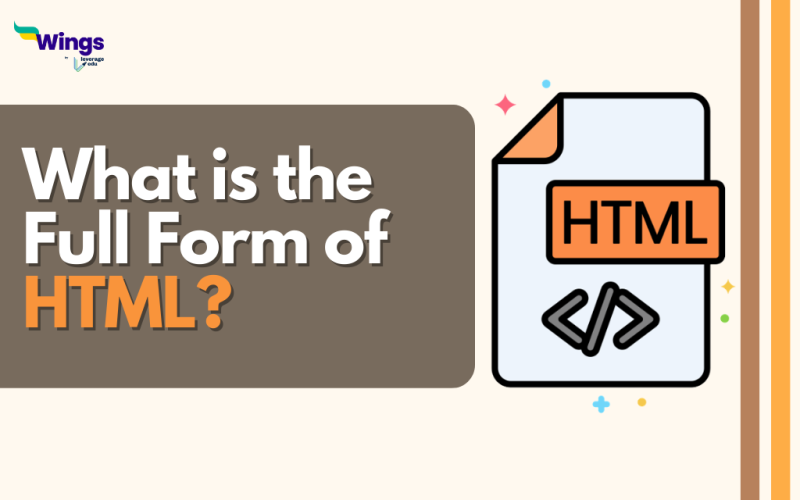HTML full form is Hypertext Markup Language. A markup language, written in the style of HTML elements, generates web pages. A hyperlink is a series of connections within a page to other pages. Markup language refers to the use of tags to specify the page layout and elements. It primarily focuses on displaying information on web pages; in other words, people write internet web pages in HTML code. Web browsers interpret and display HTML pages. Google Chrome, Mozilla Firefox, Opera, Safari, and Internet Explorer are some well-known online browsers.
Table of Contents
History of HTML
Physicist Tim-Berners Lee created this basic yet brilliant language in 1990, but it was not officially released until 1993. Since then, the HTML language has seen various different forms being released. It has now become the official standard for web pages because of its popularity and quick implementation on websites. HTML5 was one of the most significant and prominent launches among countless upgrades because it brought several new features.
Also Read – What is the Full Form of DHTML?
Characteristics of HTML
- Simple to understand: It is the most straightforward language you can say, very simple to learn and grow.
- Flexibility: This language is so versatile that you can create anything you desire, including a flexible approach to designing web pages with the content.
- Linkable text: You can create linkable text so that users can connect from one page to another or from one website to another.
- You can add whatever movies, GIFs, photographs, or sounds you like to make the website more appealing and understandable.
- Support: This language can be used to display documents on any platform, including Windows, Linux, and Mac.
- HTML is not a programming language because it is only concerned with delivering information on the internet. It is not used to program logic, but rather to provide structure and semantic meaning to our website. We may, however, attach JavaScript code to it, which is a programming language.
- Language Support: HTML may support a variety of other languages such as JavaScript, Ruby, PHP, Perl, and others. During the runtime, you can also run embed Python.
Also Read – What is the Full Form of HTTP?
Features of HTML
Because of its numerous sophisticated features, the current HTML5 version is gaining popularity. Among them are the following:
- Video: Users can stream videos from a website using the video element.
- Figure: The figure element aids in the display of visual content such as images, illustrations, diagrams, and so on.
- Section elements, such as divs, aid in the organization of the content into subject sections.
- NAV: It refers to the section of a website that is linked to other pages on the website.
- Header: It allows you to collect together introductory aspects of your website, such as your logo, navigation items, search form, and so on.
- Footer: The footer is at the bottom of a webpage. It typically includes copyright information, social networking links, and navigation components.
Also Read – What is the Full Form of DOM?
Advantages of HTML
HTML has the following advantages.
- HTML is easily connected with a variety of programming languages, such as PHP and Node.js.
- HTML is one of the most popular and frequently used languages, with a large community and a wealth of resources.
- HTML offers a flat learning curve and is compatible with all web browsers.
- HTML is one of the most basic markup languages available.
- HTML is totally open-source and free.
- The World Wide Web Consortium (W3C) maintains the HTML web standard.
Also Read – What is the full form of CSS in Computer?
Drawbacks of HTML
Along with many advantages, HTML (full form Hypertext Markup Language) also has certain drawbacks. Some of them are listed below.
- If a customer demands dynamic web pages, HTML is ineffective because only simple and static pages may be generated.
- To develop simple web pages, a user would need to do a lot of coding.
- HTML security requirements are not up to grade or acceptable.
- Some difficulty arises when a user is required to design a lengthy system in order to create a web browser.
Example of HTML Document
<!DOCTYPE>
<html>
<body>
<h1>Write Your First Heading</h1>
<p>Write Your First Paragraph.</p>
</body>
</html>
Must Read: What is the Full Form of iOS?
Must Read: What is SQL Full Form?
Popular Full Forms
We hope this blog has helped you understand the HTML full form and everything related to it. If you want to know more, find the 300+ full forms list on our blog. In the world of short forms, you can rely on the Leverage edu page to know about more full forms like this! Connect with us study abroad experts to achieve your international dream today!
 One app for all your study abroad needs
One app for all your study abroad needs













